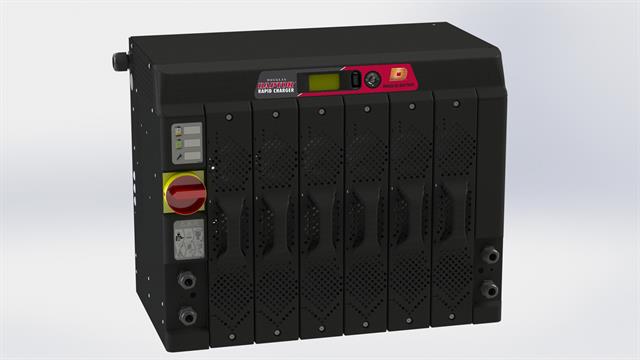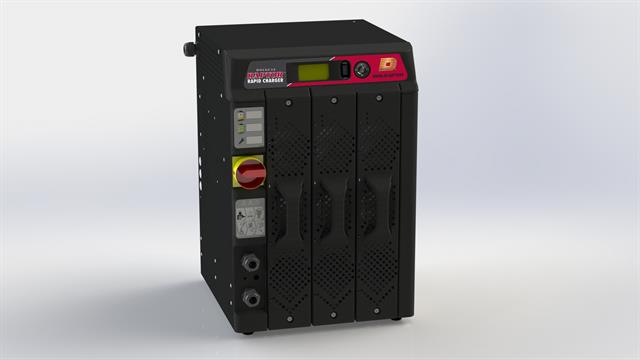 6 bay Raptor™ rapid charger by Douglas Battery™ |
Recharge Batteries Up to Five Times Faster with the RAPTOR™ Rapid Charger by Douglas Battery™We're a progressive bunch here in the materials handling industry. After all, we've outpaced the consumer automobile market worldwide in adopting electric-powered forklifts and warehouse handling vehicles. We accept battery-powered forklifts as the optimum choice - they're familiar, reliable and cost-effective. They're also quieter, have fewer moving parts/require less maintenance and with fewer emissions, are better for the environment than forklifts powered by internal combustion (IC) engines.
As an industry, we've easily made the leap from IC to electric - and we've taken it a step further. Today, fast charging is a mainstream charging technology due to the added benefits and savings it offers. With a rapid charge system, warehouse managers are able to return batteries to a full charge three to five times faster than compared to conventional chargers. For those operations that have not yet transitioned to fast charging, it's worth some serious consideration.
Here's how it works:With conventional charging, batteries are typically rotated in three eight-hour shifts. For example, the batteries that are used during the first shift are charged during the second shift. Conventional chargers deliver a full charge by using a higher charge rate during the first few hours that slows as the battery nears its full capacity. Lead acid batteries are exothermic during charging and can become quite hot. They require a cool down period to avoid thermal runaway (this happens during recharge, not in application). This usually takes another six to eight hours. Facilities running multiple shifts require additional batteries to avoid downtime and keep the forklift fleet in operation. While some may argue that conventional charging delivers the best longevity from the battery, the trade-offs include the purchase of additional batteries, downtime to swap them out and the inherent risks associated with extra battery handling.
A rapid charge system, on the other hand, charges a battery much quicker - often in as little as two to four hours. Rapid chargers are able to deliver this faster recharge by maintaining a constant high rate of current. Since this may increase gassing and the potential for sulfation, fast chargers may avoid this by only delivering a re-charge of 80-85 percent. In addition, many offer a periodic equalize charge, a deliberate overcharge that helps to remove sulfate crystals that have built up on the plates.
Benefits of Rapid ChargingRapid charging delivers a number of benefits to those operations seeking to enhance bottom line results. For those companies, such as online retailers and mass merchandisers, who rely heavily on their materials handling operation, rapid charging may yield a distinct competitive advantage. Benefits include:
- Fewer Batteries: By dramatically reducing charging time, many warehouse managers find that rapid charging eliminates the need for multiple batteries per forklift, as batteries can be recharged in the forklift.
- Enhanced Safety: When batteries are changed manually or using a crane, there is an inherent risk of injury/damage if the battery is accidentally dropped. With rapid charging, battery changing and the associated handling risks are reduced.
- More Space: Since rapid charging eliminates the need for battery changes, there also is no need for a battery room, enabling that space to be repurposed. Likewise, the dedicated battery room attendant may now be utilized elsewhere in the facility.
- Improved Productivity: Rapid charging also helps to increase operator productivity by eliminating the time wasted changing out batteries, especially in multi-shift operations.
- Increased Asset Utilization: In a three-shift operation with conventional charging, asset utilization may be as low as 33 percent. Since only a single battery is needed for each forklift during fast charging, battery utilization rises to a full 100 percent.
When is Rapid Charging a Good Fit?When determining whether to adopt a rapid -charge system, it is important to recognize if there is a need. Your operation may benefit from rapid charging if the following conditions exist:
- Multiple Shifts/Battery Changes: Rapid charging is generally suitable for facilities working more than one shift per day and/or those that are changing out at least one battery per day. The more operating hours/battery changes, the greater the potential for savings.
- Need for Added Space: For operations looking to open up valuable floor space, rapid charging may provide the ideal solution by eliminating the need for a battery room. This space may be repurposed.
- New Construction/Expansion: Prior to new construction, companies may ramp up their operations to meet increased demands. rapid charging can help bridge the gap, providing added efficiencies during the transition and into the future.
- Desire to Improve Productivity: With rapid charging, productivity is improved as the battery does not need to be changed and charged/cooled over multiple shifts. Downtime is eliminated for both the forklift operator and the battery itself. Both are available to work all day, every day.
- Enhanced Safety: No battery changes mean less risk of injury during battery handling. In addition, forklift traffic to and from the battery room also is eliminated, decreasing the potential for accidents.
- IC to Electric Conversions: Rapid charging systems only require one battery and one charger per forklift, as opposed to multiple batteries/chargers per truck. This may make it more affordable for those companies interested in converting to electric.
A Look at the Bottom LineWe all know that major operational decisions always come down to dollars and cents. Although converting to rapid charge batteries and chargers initially may require an increased capital investment, cost models demonstrate that operational savings may offset this investment in less than six months.
Choosing the Right Rapid ChargerNot all rapid chargers are created equal. They all may reduce charging time, but that's where the difference ends.
For a thorough evaluation, it is important to first look at the manufacturer. Has the company been in business for a long time? Some of the oldest, most reliable firms have been serving the materials handling industry for almost 100 years! Do they have a good reputation? Do they have an established family of products with patented technologies? Can they support your needs as you grow? Do they have a service team ready to help you whenever and wherever you need it?
Next, product quality and construction is key. Are the products made well? Do they meet stringent industry standards, such as the California Energy Commission (CEC) Standards? Do they offer innovative solutions that set their products apart? Does the company stand behind its products with a solid warranty?
 3 bay Raptor™ rapid charger by Douglas Battery™ |
Introducing the Raptor™ Rapid Charger by Douglas Battery™The
Raptor™ rapid charger by Douglas Battery meets these criteria and more. The Raptor
™ rapid charger can be used whenever a full or partial charge is needed and returns batteries to a full state of charge three to five times faster than conventional chargers.
By charging during normal shift breaks and forklift downtimes, battery changes can be virtually eliminated, avoiding productivity downtime and ultimately reducing operating costs.
Available for both wall and floor mounting, the modular configuration of the
Raptor™ rapid charger provides the flexibility to maintain optimum efficiency at all times. If a module faults, the charger bypasses the module in order for charging to continue to keep operations productive.
In addition, the charger returns batteries to a full state of charge without generating excess heat and protecting the battery from damage due to excessive heat.
The Raptor
™ rapid charger is compatible with the Douglas DataTrac
™ battery monitoring system, which collects data about the battery's usage, charge return, water level, temperature and equalization.
The
Douglas Battery™ network of manufacturer's representatives and service technicians stand ready to assist you and help keep your operation running smoothly with 24/7 emergency service, if needed.
Taking the Next StepStill not sure if fast charging is for you? Call Douglas Battery
™ today for a free evaluation and to arrange an onsite power study.
For more information, please call Douglas Battery™ toll-free at 1-800-211-3684 or visit www.douglasbattery.com. ABOUT DOUGLAS BATTERY™
Douglas Battery is a brand of EnerSys, the world leader in stored energy solutions for industrial applications. Since 1921, Douglas Battery had maintained the reputation of producing and delivering the highest quality products in the industry, and has remained a customer-focused company that anticipates and responds to customers' needs. More information regarding Douglas Battery can be found at www.douglasbattery.com.
Amanda Fuller -Douglas Battery
t: 610-208-1869
e: send an email
w: www.douglasbattery.com
ABOUT ENERSYS®
EnerSys, the global leader in stored energy solutions for industrial applications, manufactures and distributes reserve power and motive power batteries, battery chargers, power equipment, battery accessories and outdoor equipment enclosure solutions to customers worldwide. Motive power batteries and chargers are utilized in electric forklifts and other commercial electric-powered vehicles. Reserve power batteries are used in the telecommunication and utility industries, uninterruptible power supplies, and numerous applications requiring stored energy solutions including medical, aerospace and defense systems. Outdoor equipment enclosure products are utilized in the telecommunication, cable, utility, transportation industries and by government and defense customers. The company also provides aftermarket and customer support services to its customers from over 100 countries through its sales and manufacturing locations around the world. More information regarding EnerSys can be found at www.enersys.com.
1 http://www.mhi.org/media/members/17127/130197613453828886.pdf